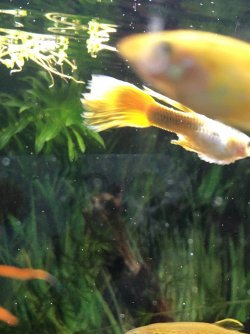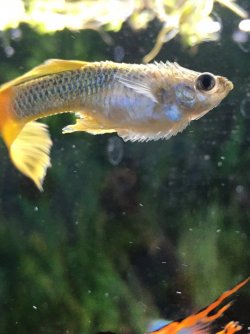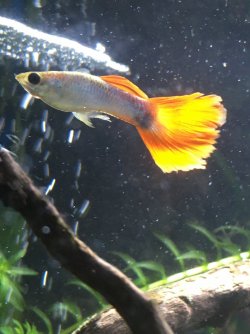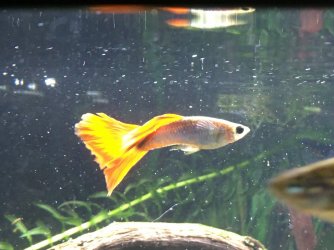You are using an out of date browser. It may not display this or other websites correctly.
You should upgrade or use an alternative browser.
You should upgrade or use an alternative browser.
Help! Male guppy so swollen scales sticking out
- Thread starter A Fishkeeper
- Start date
April FOTM Photo Contest Starts Now!

🏆 Click to enter! 🏆
awolf3303
New Member
I am pretty sure he has dropsy, as "pineconing" and a bloated stomach are two symptoms of it. What are your water parameters?
A Fishkeeper
New Member
I’ve euthanised the fish because everything I read said dropsy. I checked yesterday out of routine and everything was as should beI am pretty sure he has dropsy, as "pineconing" and a bloated stomach are two symptoms of it. What are your water parameters?
Ammonia 0
nitrite 0
Nitrate 50
A week ago there was a problem with the water in my area and I lost 3 fish. Sadly I assume this is the result of that. The fish shop said lots had people had been losing fish after water changes like me that weekend.
It had dropsy. It is usually caused by a bacterial infection in the body/ organs and there is no cure because there is massive organ damage by the time the scales stick out.
Wipe the inside of the glass down with a clean fish sponge.
Do a 75% water change and gravel clean the substrate every day for a week. The water changes and gravel cleaning will reduce the number of disease organisms in the water and provide a cleaner environment for the remaining fish to recover in.
Make sure any new water is free of chlorine/ chloramine before it is added to the tank.
Clean the filter if it hasn't been done in the last 2 weeks. However, if the filter is less than 6 weeks old, do not clean it. Wash the filter materials/ media in a bucket of tank water and re-use them. Tip the bucket of dirty water on the garden/ lawn. Cleaning the filter means less gunk and cleaner water with fewer pathogens.
Wipe the inside of the glass down with a clean fish sponge.
Do a 75% water change and gravel clean the substrate every day for a week. The water changes and gravel cleaning will reduce the number of disease organisms in the water and provide a cleaner environment for the remaining fish to recover in.
Make sure any new water is free of chlorine/ chloramine before it is added to the tank.
Clean the filter if it hasn't been done in the last 2 weeks. However, if the filter is less than 6 weeks old, do not clean it. Wash the filter materials/ media in a bucket of tank water and re-use them. Tip the bucket of dirty water on the garden/ lawn. Cleaning the filter means less gunk and cleaner water with fewer pathogens.
A Fishkeeper
New Member
Thank you. I’ll get stared on this right away.It had dropsy. It is usually caused by a bacterial infection in the body/ organs and there is no cure because there is massive organ damage by the time the scales stick out.
Wipe the inside of the glass down with a clean fish sponge.
Do a 75% water change and gravel clean the substrate every day for a week. The water changes and gravel cleaning will reduce the number of disease organisms in the water and provide a cleaner environment for the remaining fish to recover in.
Make sure any new water is free of chlorine/ chloramine before it is added to the tank.
Clean the filter if it hasn't been done in the last 2 weeks. However, if the filter is less than 6 weeks old, do not clean it. Wash the filter materials/ media in a bucket of tank water and re-use them. Tip the bucket of dirty water on the garden/ lawn. Cleaning the filter means less gunk and cleaner water with fewer pathogens.
i replaced half my filter sponge with new last week so shall I leave the whole filter alone?
at the moment I have an internal filter but I was thinking to get an external. (Not today) but do you think that would be a good move long term?
A Fishkeeper
New Member
Do you think it’s worth dosing being melafix as well? One of my other guppies is sitting at top of water. Tail and fins still beautifully orange but body has lost its flecks of blue.
Don't add melafix.
Post pictures of the other fish.
Don't replace filter media/ material. Just wash it out in a bucket of tank water and re-use the media. Tip the bucket of dirty water on the lawn.
If the filter media starts to break down, replace it with a piece of sponge. You can buy sponges for other brands of filter and use a pair of scissors to cut them to fit. Sponges get squeezed out in a bucket of tank water too and will last for years.
Post pictures of the other fish.
Don't replace filter media/ material. Just wash it out in a bucket of tank water and re-use the media. Tip the bucket of dirty water on the lawn.
If the filter media starts to break down, replace it with a piece of sponge. You can buy sponges for other brands of filter and use a pair of scissors to cut them to fit. Sponges get squeezed out in a bucket of tank water too and will last for years.
A Fishkeeper
New Member
A Fishkeeper
New Member
I sort the filter media when I do another large water change tomorrow like you advised.
The fish looks fine.
Check the water quality for ammonia, nitrite, nitrate and pH.
Do a big water change, gravel clean the substrate, then add some salt.
----------------------
You can add rock salt (often sold as aquarium salt), sea salt or swimming pool salt to the aquarium at the dose rate of 1 heaped tablespoon per 20 litres of water. If there is no improvement after 48 hours you can double that dose rate so there is 2 heaped tablespoons of salt per 20 litres.
If you only have livebearers (guppies, platies, swordtails, mollies), goldfish or rainbowfish in the tank you can double that dose rate, so you would add 2 heaped tablespoons per 20 litres and if there is no improvement after 48 hours, then increase it so there is a total of 4 heaped tablespoons of salt per 20 litres.
Keep the salt level like this for at least 2 weeks but no longer than 4 weeks otherwise kidney damage can occur. Kidney damage is more likely to occur in fish from soft water (tetras, Corydoras, angelfish, Bettas & gouramis, loaches) that are exposed to high levels of salt for an extended period of time, and is not an issue with livebearers, rainbowfish or other salt tolerant species.
The salt will not affect the beneficial filter bacteria but the higher dose rate (4 heaped tablespoons per 20 litres) will affect some plants and some snails. The lower dose rate (1-2 heaped tablespoons per 20 litres) will not affect fish, plants, shrimp or snails.
After you use salt and the fish have recovered, you do a 10% water change each day for a week using only fresh water that has been dechlorinated. Then do a 20% water change each day for a week. Then you can do bigger water changes after that. This dilutes the salt out of the tank slowly so it doesn't harm the fish.
If you do water changes while using salt, you need to treat the new water with salt before adding it to the tank. This will keep the salt level stable in the tank and minimise stress on the fish.
Check the water quality for ammonia, nitrite, nitrate and pH.
Do a big water change, gravel clean the substrate, then add some salt.
----------------------
You can add rock salt (often sold as aquarium salt), sea salt or swimming pool salt to the aquarium at the dose rate of 1 heaped tablespoon per 20 litres of water. If there is no improvement after 48 hours you can double that dose rate so there is 2 heaped tablespoons of salt per 20 litres.
If you only have livebearers (guppies, platies, swordtails, mollies), goldfish or rainbowfish in the tank you can double that dose rate, so you would add 2 heaped tablespoons per 20 litres and if there is no improvement after 48 hours, then increase it so there is a total of 4 heaped tablespoons of salt per 20 litres.
Keep the salt level like this for at least 2 weeks but no longer than 4 weeks otherwise kidney damage can occur. Kidney damage is more likely to occur in fish from soft water (tetras, Corydoras, angelfish, Bettas & gouramis, loaches) that are exposed to high levels of salt for an extended period of time, and is not an issue with livebearers, rainbowfish or other salt tolerant species.
The salt will not affect the beneficial filter bacteria but the higher dose rate (4 heaped tablespoons per 20 litres) will affect some plants and some snails. The lower dose rate (1-2 heaped tablespoons per 20 litres) will not affect fish, plants, shrimp or snails.
After you use salt and the fish have recovered, you do a 10% water change each day for a week using only fresh water that has been dechlorinated. Then do a 20% water change each day for a week. Then you can do bigger water changes after that. This dilutes the salt out of the tank slowly so it doesn't harm the fish.
If you do water changes while using salt, you need to treat the new water with salt before adding it to the tank. This will keep the salt level stable in the tank and minimise stress on the fish.
A Fishkeeper
New Member
I have a bristlenose cat fish, my understanding they can’t have salt added?
also have danios, mollies, endlers and assassin snails.
pH 7.2
Ammonia 0
Nitrite 0
also have danios, mollies, endlers and assassin snails.
pH 7.2
Ammonia 0
Nitrite 0
Latest Discussions
- Replies
- 4
- Views
- 53
- Replies
- 9
- Views
- 56
- Replies
- 6
- Views
- 68
trending
-
-
-
-
F-1 Angel... a bit nervous... it'll be my 1st F-1 fish...
- Started by Magnum Man
- Replies: 13
-
Members online
Total: 453 (members: 6, guests: 447)






